When the weather heats up or we’re craving something refreshingly tropical, nothing beats the perfect blend of sweet mango and tangy pineapple in a creamy smoothie. This mango pineapple smoothie recipe captures the essence of paradise in every sip while delivering a powerful punch of vitamins C and A that’ll energize your day.
We’ve perfected this recipe to achieve the ideal balance between tropical sweetness and smooth texture. The natural sugars from ripe mango pair beautifully with pineapple’s bright acidity, creating a flavor combination that’s both satisfying and incredibly refreshing. Whether you’re looking for a quick breakfast on-the-go or a healthy afternoon treat, this smoothie delivers every time.
What makes our version special is its simplicity and versatility. With just a handful of ingredients and two minutes of blending, you’ll have a restaurant-quality smoothie that’s naturally gluten-free and can easily be made vegan. Let’s jump into creating this tropical masterpiece that’ll transport you straight to the beach.
Ingredients
We’ve carefully selected ingredients that create the perfect balance of tropical flavors and creamy texture. Our mango pineapple smoothie requires just a few simple components that blend together beautifully.
Fresh Fruits
- 1 cup frozen mango chunks (or 1 large fresh mango, peeled and cubed)
- 1 cup frozen pineapple chunks (or 1 cup fresh pineapple, cored and cubed)
- 1 medium banana (for natural sweetness and creaminess)
Liquid Base Options
- 1 cup coconut milk (canned or carton for richness)
- 1 cup almond milk (unsweetened for lighter texture)
- 1 cup whole milk (for traditional creaminess)
- 1 cup orange juice (for extra citrus brightness)
- ¾ cup water plus ¼ cup coconut cream (for customized consistency)
Optional Add-ins
- 1 tablespoon honey or maple syrup (for additional sweetness)
- ½ cup vanilla Greek yogurt (for protein and tang)
- 1 tablespoon chia seeds (for omega-3s and fiber)
- ½ teaspoon fresh ginger, grated (for subtle spice)
- ¼ cup rolled oats (for heartier texture)
- 1 tablespoon coconut flakes (for tropical enhancement)
- Ice cubes as needed (for thicker consistency)
Equipment Needed
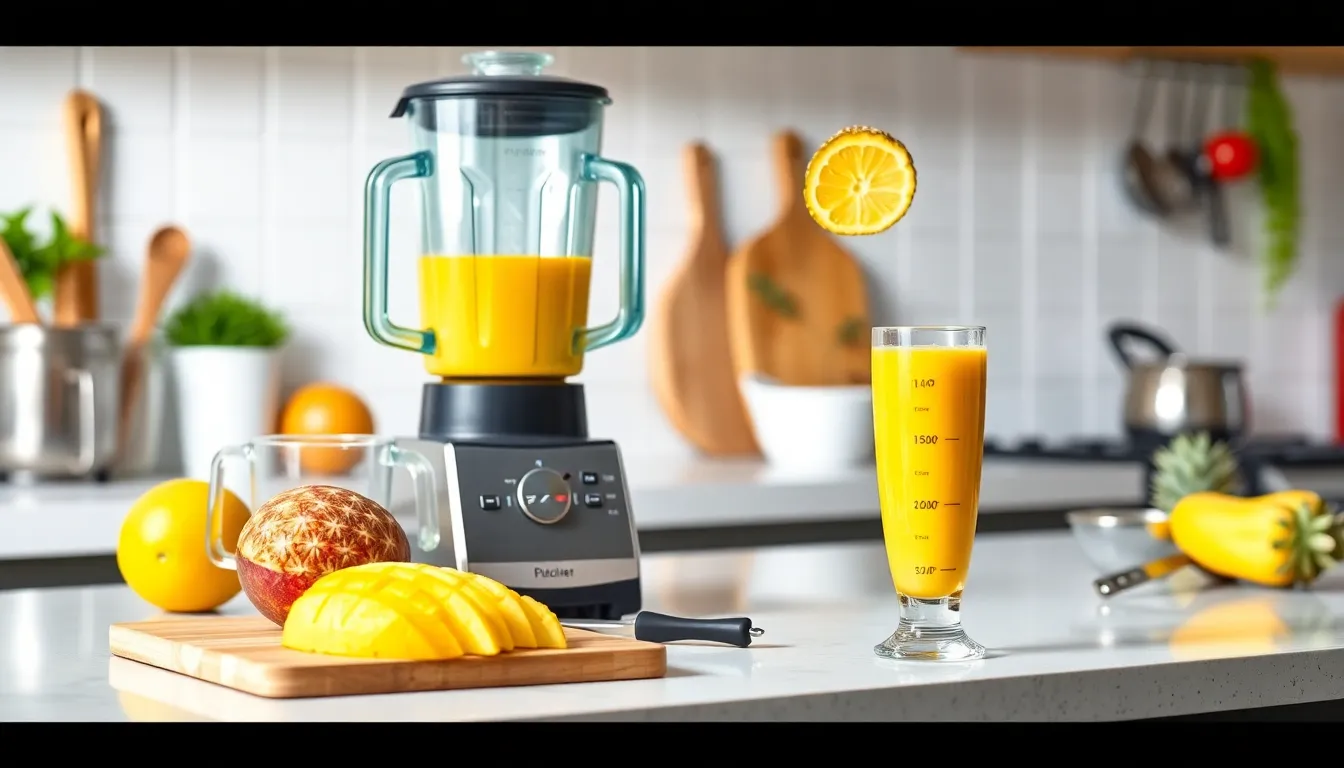
Creating our perfect mango pineapple smoothie requires minimal kitchen equipment that most home cooks already have on hand. We’ll walk you through the essential tools needed to achieve that smooth, creamy texture we’re aiming for.
High-powered blender serves as our most crucial piece of equipment for this recipe. A quality blender ensures our frozen fruits blend smoothly without leaving chunks or creating an uneven texture. Standard kitchen blenders work perfectly well for this smoothie, though high-speed models like Vitamix or Blendtec will process frozen ingredients more efficiently.
Measuring cups help us achieve the perfect flavor balance in our tropical smoothie. We recommend having both liquid and dry measuring cups available, as accuracy matters when combining our mango, pineapple, and liquid base ingredients.
Measuring spoons become essential for our smaller ingredients like lemon juice and optional honey additions. These precise measurements ensure our smoothie maintains its optimal sweet and tangy flavor profile.
Cutting board and sharp knife prove necessary when working with fresh fruits that require preparation. We’ll need these tools for peeling fresh mango, removing pineapple core, and slicing banana if we’re not using pre-cut frozen varieties.
Serving glasses complete our equipment list, though any tall glass or smoothie cup works beautifully for presentation. We suggest chilled glasses to keep our smoothie at the perfect temperature for serving.
Most kitchens already contain these basic tools, making our mango pineapple smoothie an accessible recipe for smoothie enthusiasts at any skill level.
Instructions
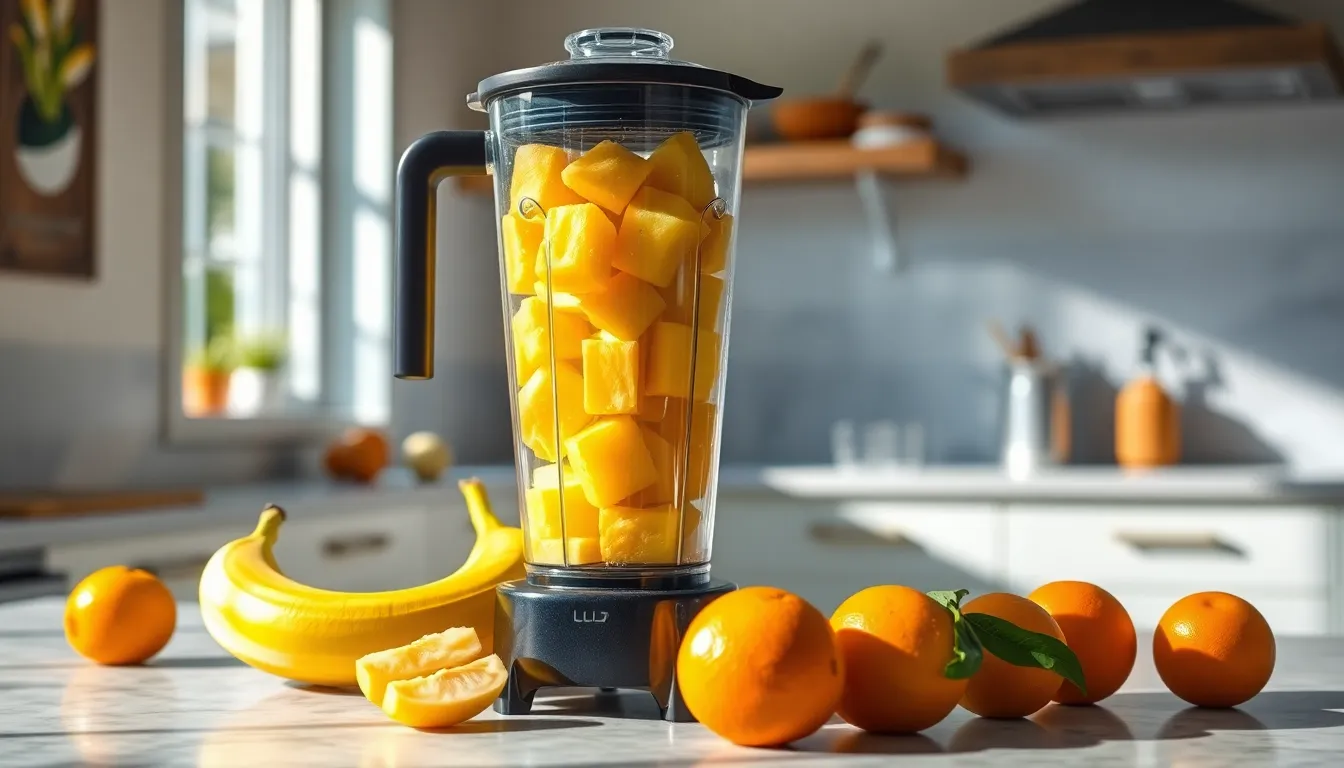
Creating this tropical mango pineapple smoothie requires just a few simple steps and takes only minutes from start to finish. We’ll guide you through each phase to ensure you achieve the perfect creamy texture and balanced flavor.
Prep the Fruits
We recommend using 1 cup frozen mango and 1 cup frozen pineapple for optimal texture and chill. Pre-freezing the fruit cubes delivers a creamier and thicker result compared to fresh fruit alternatives. Measure out your frozen fruits and set them aside while you gather the remaining ingredients.
Optional additions like a small banana or clementines can enhance the natural sweetness and add extra tropical flavor. If you’re planning to include 1/3 cup Greek yogurt for added creaminess, have it ready at room temperature for easier blending.
Blend the Smoothie
Place the frozen mango, pineapple, 1¼ cup almond milk, and ¼ cup Greek yogurt into your high-powered blender. Start by pulsing the blender to break up large fruit chunks before moving to continuous blending. Blend on high speed until the mixture becomes fully creamy and smooth.
Alternative liquid options include 1/4 cup orange juice or 1 cup milk if you prefer different flavor profiles or don’t have almond milk available. The recipe yields approximately 2 servings when following these measurements.
Adjust Consistency and Taste
Check the consistency after your initial blend and add small amounts of milk or water if the smoothie appears too thick. Blend again briefly after each liquid addition to maintain the smooth texture. Taste your creation and add 2 tablespoons maple syrup or honey if extra sweetness is desired.
Serve immediately for best results since the smoothie may separate or thin when left standing. The ideal temperature and texture are achieved when consumed fresh from the blender.
Serving Suggestions

We recommend enjoying our mango pineapple smoothie as a refreshing breakfast drink to kickstart your morning with tropical flavors. The vibrant combination of mango and pineapple provides natural energy while delivering essential vitamins and minerals your body craves.
Pour the smoothie into chilled glasses for the ultimate refreshing experience. We love serving this tropical blend during afternoon snack time when you need a quick pick-me-up between meals. The natural sweetness satisfies cravings without the guilt of processed snacks.
Fresh mint leaves make an excellent garnish that adds visual appeal and a hint of freshness to each sip. We suggest placing 2-3 mint leaves on top of the smoothie just before serving. Coconut flakes provide another delightful topping option that enhances the tropical theme while adding texture contrast.
Post-workout nutrition becomes more enjoyable when you reach for this nutrient-dense smoothie. We find that the natural sugars help replenish energy stores while the optional protein powder supports muscle recovery. The combination works perfectly after morning exercise routines or afternoon gym sessions.
Light meal pairings complement this smoothie beautifully without overwhelming your palate. We recommend serving alongside whole grain toast with almond butter or a small bowl of granola with fresh berries. These combinations create balanced meals that satisfy hunger while maintaining the tropical flavor profile.
Presentation matters when serving guests or family members. We suggest using clear glasses to showcase the beautiful golden color of the smoothie. A colorful paper straw or bamboo straw adds an eco-friendly touch that complements the natural ingredients.
Storage Tips
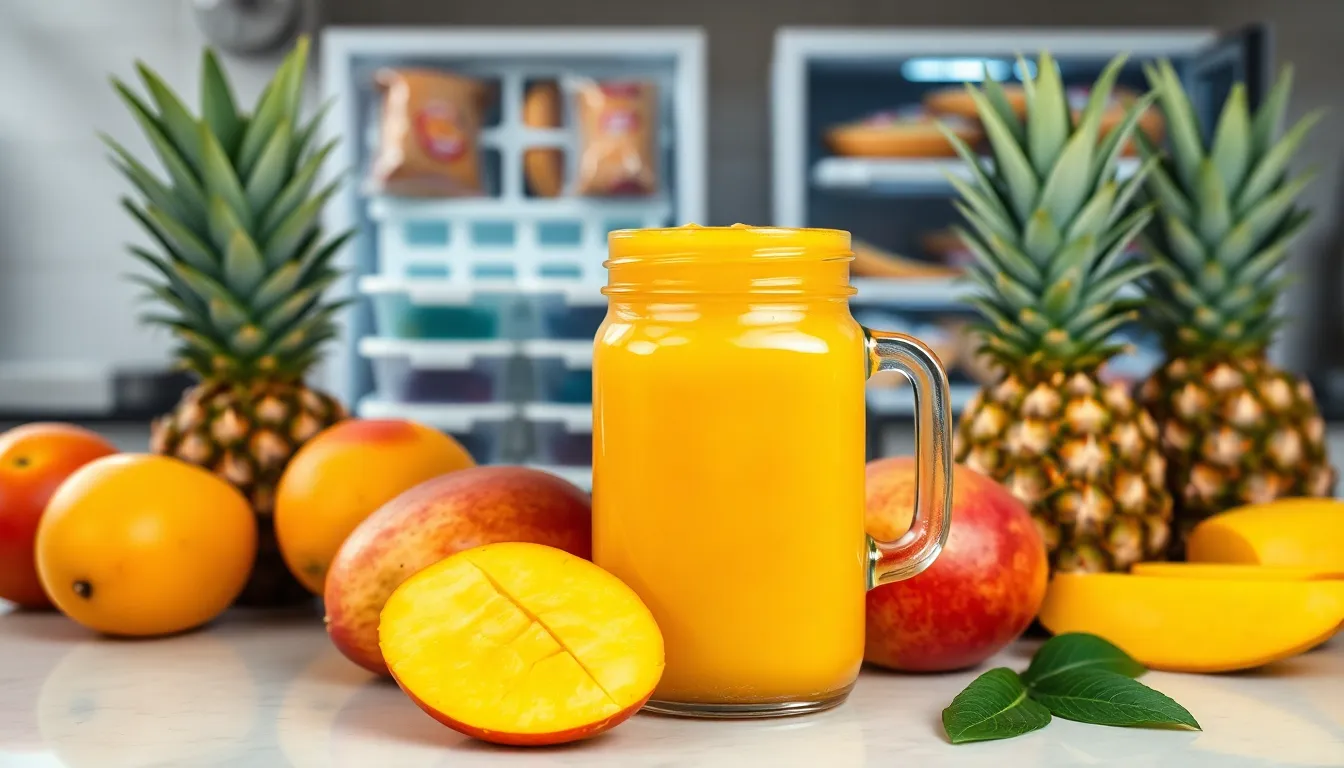
We recommend storing your leftover mango pineapple smoothie in an airtight container such as a mason jar or lidded cup for optimal freshness. The smoothie maintains its best quality when consumed within 1 to 2 days of preparation though it can last up to 4 days in the refrigerator.
| Storage Method | Duration | Container Type |
|---|---|---|
| Refrigerator | 1-2 days (best quality) | Mason jar or lidded cup |
| Refrigerator | Up to 4 days (acceptable) | Airtight container |
| Freezer (cubes) | Up to 1 month | Ice cube trays then zip-top bag |
| Freezer (ingredient packs) | Several weeks | Individual freezer bags |
Separation occurs naturally during storage so we always shake or stir the smoothie before drinking. This normal process doesn’t affect the taste or nutritional value of your tropical blend.
For longer storage we freeze the blended smoothie in ice cube trays or popsicle molds. Once frozen solid we transfer the cubes to a zip-top bag where they stay fresh for up to a month. When ready to enjoy we thaw the cubes and reblend with a splash of liquid or add frozen fruit for extra thickness.
Creating ready-to-blend packs saves time for busy mornings. We pre-measure and freeze mango and pineapple chunks in individual bags then simply blend with liquid and optional add-ins when craving strikes.
Keeping your blender clean between recipes prevents flavor transfer and ensures each smoothie tastes exactly as intended. We rinse immediately after use and perform a thorough cleaning to maintain the equipment’s performance and longevity.
Variations
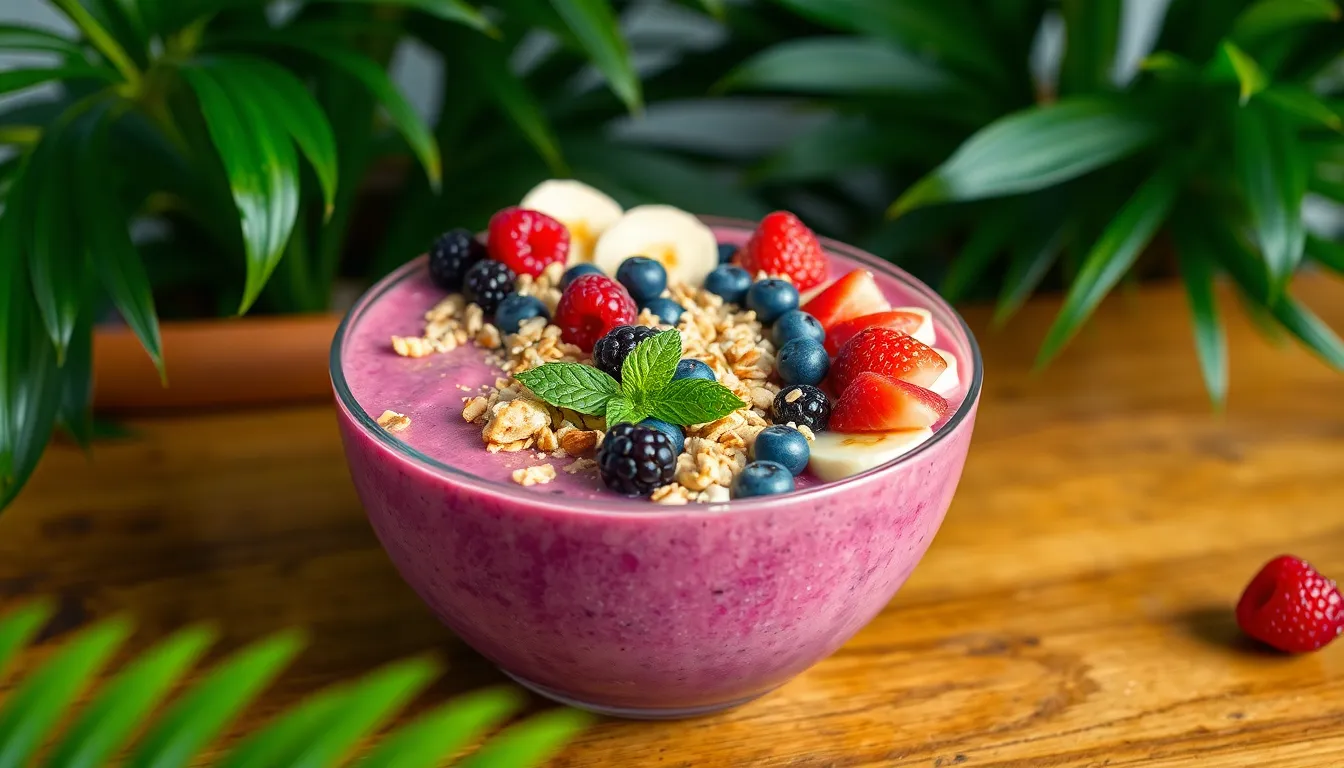
Transform our basic mango pineapple smoothie into exciting new versions that suit different tastes and nutritional goals. Each variation builds upon the delicious foundation while adding unique elements to enhance flavor and health benefits.
Tropical Green Smoothie
We love sneaking extra nutrients into our smoothies with leafy greens that blend seamlessly with tropical flavors. Add 1 cup of fresh spinach, kale, chard, mint, or sprouts to our basic mango pineapple recipe for a vibrant green boost. The sweet mango and tangy pineapple perfectly mask any earthy green taste, making this version ideal for those new to green smoothies.
Use water or plant milk as your liquid base to keep the tropical flavors bright and clean. For added nutrition, we recommend incorporating 2 tablespoons of seeds such as pumpkin, sunflower, hemp, chia, or flax seeds. These powerhouse additions provide healthy fats, protein, and fiber while maintaining the smoothie’s creamy texture.
Protein-Packed Version
Athletes and fitness enthusiasts will appreciate this protein-rich variation that supports muscle recovery and sustained energy. Blend 1 to 2 scoops of vanilla protein powder directly into our basic recipe for a satisfying post-workout treat. The vanilla flavor complements the tropical fruits beautifully without overpowering their natural sweetness.
Coconut water or pineapple juice work exceptionally well as liquid bases in this version, adding electrolytes and improving the tropical flavor profile. This combination creates a smoothie that tastes like a vacation while delivering the protein your body needs for optimal recovery and muscle building.
Frozen Smoothie Bowl
Create an Instagram-worthy smoothie bowl by reducing the liquid in our basic recipe to achieve a thick, spoonable consistency. This variation transforms your drink into a satisfying meal that you can customize with endless toppings. The thicker texture allows for beautiful presentation while providing a more substantial eating experience.
Top your smoothie bowl with fresh fruits like sliced bananas, berries, or kiwi for natural sweetness and vibrant colors. Add granola for satisfying crunch, nuts for healthy fats, or seeds for extra nutrition. Serve immediately in a chilled bowl with a spoon to enjoy this tropical treat that feels like healthy ice cream.
Nutritional Benefits
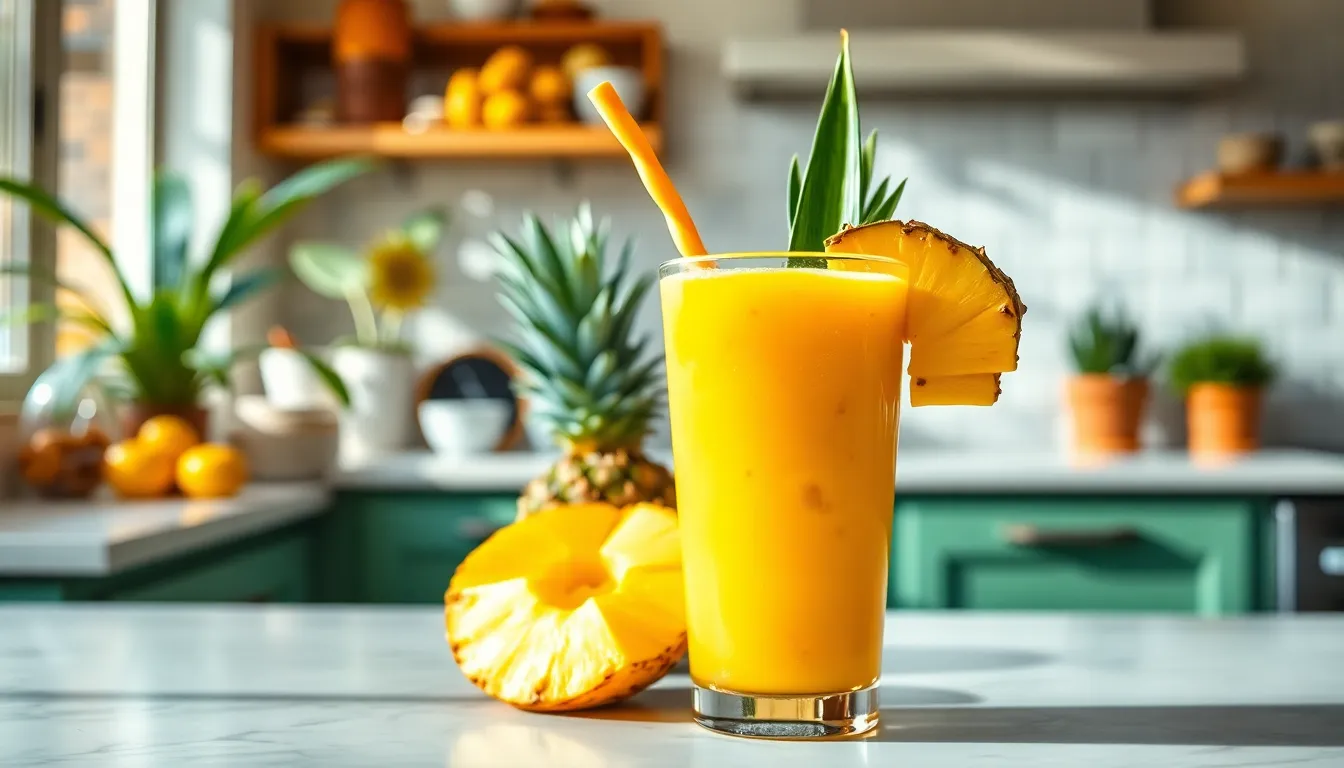
Our mango pineapple smoothie delivers an impressive array of essential nutrients that support overall health and wellness. The combination of these tropical fruits creates a powerhouse drink that goes far beyond just great taste.
Vitamin C stands as the star nutrient in this smoothie blend. Both mango and pineapple provide exceptionally high levels of this immune-boosting vitamin that supports skin health and helps our bodies fight off infections. We get additional vitamins from the mango including vitamins A, E, and K which contribute to eye health, antioxidant protection, and blood clotting functions.
The pineapple brings a unique enzyme called bromelain that sets this smoothie apart from other fruit blends. This powerful enzyme offers anti-inflammatory properties and supports healthy digestion by helping break down proteins more effectively.
| Nutritional Component | Primary Source | Key Benefits |
|---|---|---|
| Vitamin C | Mango & Pineapple | Immune support, skin health |
| Bromelain | Pineapple | Anti-inflammatory, digestion aid |
| Potassium | Both fruits | Blood pressure regulation, bone health |
| Antioxidants | Mango & Pineapple | Cell protection, inflammation reduction |
| Dietary Fiber | Both fruits | Digestive health, gut support |
Potassium content in both fruits helps regulate blood pressure naturally while supporting bone health maintenance. This essential mineral works alongside other nutrients to keep our cardiovascular system functioning optimally.
Antioxidants from both tropical fruits protect our cells against damage from free radicals and help reduce inflammation throughout the body. These protective compounds contribute to long-term health benefits and may help prevent chronic diseases.
Dietary fiber from the whole fruits aids digestion and promotes healthy gut bacteria growth. This natural fiber content helps us feel satisfied longer and supports regular digestive function.
Adding yogurt or dairy alternatives increases the protein content significantly. This protein boost helps keep us satisfied for extended periods and supports muscle maintenance and recovery. The protein also helps stabilize blood sugar levels when we enjoy this smoothie as a meal replacement or substantial snack.
Troubleshooting Tips
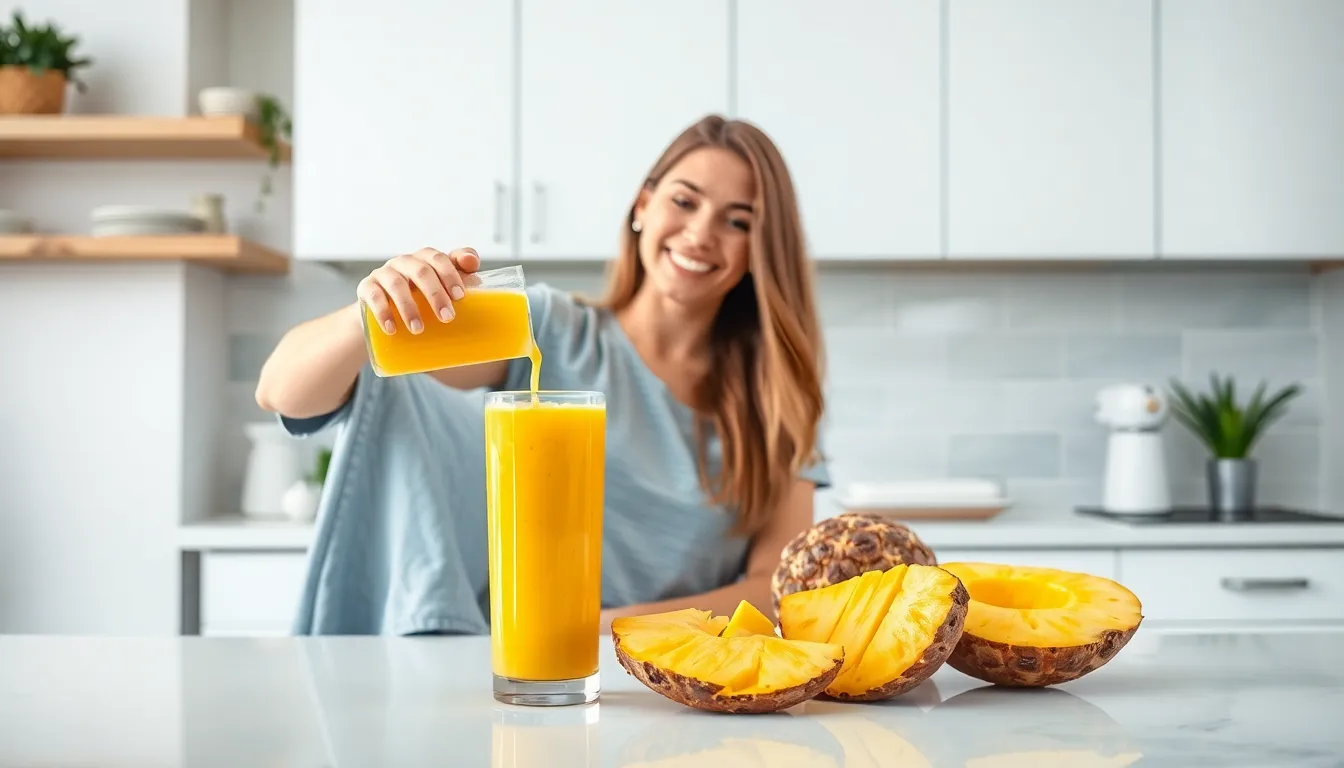
Even with our straightforward mango pineapple smoothie recipe, we sometimes encounter texture or flavor issues that need quick fixes. These common problems have simple answers that will help you achieve the perfect tropical blend every time.
Watery Consistency Issues
When our smoothie turns out too thin or watery, we recommend using more frozen fruit instead of adding ice cubes. Frozen mango and pineapple chunks naturally thicken the mixture while maintaining the intense tropical flavors we’re after. Adding Greek yogurt creates extra creaminess without diluting the taste. We can also incorporate a tablespoon of rolled oats or a small amount of nut butter to achieve the desired thickness.
Overly Thick Texture Problems
Smoothies that are too thick happen when we use too much frozen fruit or not enough liquid base. Gradually add more liquid such as coconut milk, almond milk, orange juice, or water until we reach the perfect consistency. Start with small amounts and blend between additions to avoid making the smoothie too thin. Fresh fruit can replace some frozen fruit to reduce thickness while maintaining flavor intensity.
Banana Flavor Overpowering the Mix
Sometimes the banana flavor dominates our tropical blend more than we intended. We can reduce the banana to half or eliminate it entirely if the taste becomes too strong. Replacing banana with additional mango chunks maintains the natural sweetness while keeping the tropical profile we want. Frozen cauliflower serves as an unexpected substitute that adds creaminess without affecting the flavor.
Insufficient Sweetness Levels
Natural fruit sweetness varies depending on ripeness and season. When our smoothie needs more sweetness, we add honey, maple syrup, or agave nectar one teaspoon at a time. Pitted dates provide natural sweetness along with additional fiber. Orange juice serves double duty by adding both liquid and natural sugars to enhance the overall flavor profile.
Separation During Storage
Natural separation occurs when we store our smoothies in the refrigerator. Simply shake or stir the smoothie vigorously before drinking to recombine all ingredients. Adding a small amount of Greek yogurt or chia seeds helps prevent separation by creating a more stable emulsion that holds together longer.
Conclusion
We’ve shared everything you need to create this vibrant tropical smoothie that’ll transport you straight to paradise. This simple yet nutritious blend offers endless possibilities for customization while delivering impressive health benefits that support your wellness goals.
Whether you’re looking for a quick breakfast option post-workout fuel or an afternoon treat this mango pineapple smoothie delivers on all fronts. The combination of vitamin C antioxidants and natural enzymes makes it as beneficial as it is delicious.
Don’t hesitate to experiment with our suggested variations and troubleshooting tips to make this recipe truly your own. We’re confident this tropical blend will become a regular favorite in your smoothie rotation bringing a taste of summer to any season.
Frequently Asked Questions
What ingredients do I need for a mango pineapple smoothie?
You’ll need frozen or fresh mango and pineapple chunks, a medium banana for creaminess, and your choice of liquid base like coconut milk, almond milk, or orange juice. Optional add-ins include honey, Greek yogurt, chia seeds, fresh ginger, or coconut flakes to enhance flavor and nutrition.
What equipment is essential for making this smoothie?
A high-powered blender is crucial for achieving a smooth, creamy texture. You’ll also need measuring cups and spoons for accurate proportions, a cutting board and sharp knife for fresh fruit prep, and chilled serving glasses for beautiful presentation.
How long can I store leftover mango pineapple smoothie?
Store leftover smoothie in airtight containers like mason jars in the refrigerator for 1-2 days for best quality, or up to 4 days maximum. For longer storage, freeze in ice cube trays or individual bags for ready-to-blend packs.
What are the main health benefits of this smoothie?
This smoothie is packed with vitamin C and A, supporting immune system function and skin health. Pineapple contains bromelain for anti-inflammatory benefits and digestion aid. It also provides potassium, antioxidants, and dietary fiber for overall wellness.
How can I fix a watery smoothie consistency?
Add more frozen fruit, Greek yogurt, or a frozen banana to thicken your smoothie. Using frozen ingredients instead of fresh helps create a creamier texture. You can also add rolled oats or chia seeds for additional thickness.
What are some popular variations of this smoothie?
Try a Tropical Green Smoothie by adding spinach or kale, create a Protein-Packed Version with protein powder, or make a Frozen Smoothie Bowl that’s thick enough to eat with a spoon and top with granola and fresh fruits.
When is the best time to serve this smoothie?
This smoothie works perfectly as a refreshing breakfast drink, afternoon snack, or post-workout beverage. The natural sugars provide energy replenishment, while optional protein additions support muscle recovery after exercise.
Why does my smoothie separate during storage?
Natural separation occurs when smoothie ingredients settle over time. This is completely normal. Simply shake or stir the smoothie before drinking to recombine the ingredients and restore the original creamy texture.









